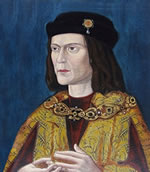
Rarely does an archaeological dig interest the general public. But an exception occurred in September 2012, when the excavation of the bones of King Richard III from beneath a parking lot in England took place.
Richard Buckley, co-director of the University of Leicester Archaeological Services, will speak about the dig and the DNA science and radiocarbon dating that helped identify the remains as those of King Richard at 5:30 p.m. today in Ellis Auditorium in Ellis Library. Buckley led the archaeological dig and the February 2013 news conference announcing the DNA and radiocarbon findings.
All are welcome to attend the event, which is sponsored by the Central Missouri society of the Archaeological Institute of America. The lecture’s title is “Richard III: The King Under the Car Park.”
Richard III, who ruled England in the 15th-century, was famously portrayed in Shakespeare’s eponymous play as a hunchbacked, power-hungry, cold-blooded murderer of royal family members (for instance, 11- and 13-year-old boys destined for the crown were smothered to death), though some historical societies have sought to offer a more balanced portrait of the king.
“Few figures in English history have been as complex and contradictory as Richard III,” said Alex Barker, director of the MU Museum of Art and Archaeology. “He was controversial in life, vilified in death, and five centuries later, he arouses strong feelings.”
Richard was gruesomely killed in battle in 1485 at age 32. Last month, Richard’s skeletal remains were reburied in Leicester Cathedral.
Learn more about the excavation and Richard III here.